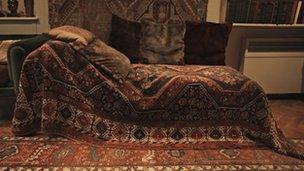Annie Leibovitz captures America
- Published
Annie Leibovitz: 'It was a kind of voyage of discovery"
Annie Leibovitz made her name photographing celebrities for publications like Rolling Stone and Vanity Fair. But her new book and exhibition Pilgrimage leave behind contemporary stars and instead show the places which evoke the historical American figures which now fascinate her.
Annie Leibovitz has photographed everyone from John Lennon and Clint Eastwood to the Queen. One thing which connects virtually all her portraits is that they were commissioned.
With the book Pilgrimage (and the related exhibition opening in London) Leibovitz has tried for once to step off the treadmill and explore at her own pace a different America.
Mainly the book pictures the homes or other places associated with US historical figures as varied as Abraham Lincoln, Elvis Presley and Louisa May Alcott (author of Little Women).
But the format is flexible enough to include pictures of the home in upstate New York of the veteran folk singer Pete Seeger, now 92, and even a small group of locations in the UK.

Annie Leibovitz: 'I'm not trying to be a great historian'
"Who knows what I was looking for?," says Leibovitz. "Honestly, at first I didn't. But that was what was so wonderful about the exercise. I picked a random group but I think eventually I saw it wasn't so random."
In 2009 Leibovitz was suffering some well-publicised financial turmoil. At that point a day-trip with her two children to Niagara Falls was an important inspiration for the project.
"I was having a difficult couple of years so I was enjoying watching the children just scamper around. Then I saw them suddenly stop, mesmerised by what they were seeing. I walked over to them and took a picture of the falls over their heads," she says.
"I was just standing by a guard-rail - it's a location anyone can go to. I only took three or four frames but when I looked at them a couple of months later at my studio in New York I was fascinated. So these are places which mean something to me in quite diverse ways.
"The other place which got me started was Emily Dickinson's house in Amherst in Massachusetts."
As with other images in the book, there's a slightly ghostly feel to Leibovitz's pictures from Amherst, all captured using a digital camera.
"In fact it was the visit to Amherst which got me thinking how remarkable are the results you now get working digitally. The Emily Dickinson house was very low-light but the images work."

Annie Oakley's shot-through card is one of the pictures that illustrate American culture
Pilgrimage is Leibovitz's first 100% digital project. The book is mainly about America Leibovitz says that didn't have to be the case.
"Anywhere you go in any country places are full of these hauntings. In New York City you can't walk down a street without encountering some historical association - but it would be the same in Paris or London."
In fact the new collection has a rural feel - the best of the landscapes suggest the great American photographer Ansel Adams. Trees and expanses of water feature throughout.
Sometimes Leibovitz is interested in the by-ways of American history, such as the life of Annie Oakley (outside America known mainly from the musical Annie Get Your Gun). There's a picture of a playing-card she's reputed to have shot through.
There are no people in the pictures so it's a shock even to encounter a statue of Abraham Lincoln - and the hat he was wearing the day he was shot at Ford's Theatre in Washington. Lincoln is one of the dominant figures.
"As a child living in suburban Washington DC the Lincoln Memorial was one of my favourite memorials - even if I didn't quite understand why," she says.
"But volumes and volumes have been written about him and I had to accept that in quite a modest work like this I had to tread lightly: I'm not trying to be a great historian.

Sigmund Freud's couch is one of a few pictures taken in the UK
"The tough thing was not getting seduced by a fantastic story like Lincoln's. I found myself driving endlessly around Kentucky looking for log cabins.
"The hat of Lincoln you see in the book is very moving. It's not just that he took it to the theatre where he was shot but also that it has a mourning band on it for his son."
As Leibovitz got further into the Pilgrimage project she began to see connections between the people featured.
"Perhaps the reason I went to see Pete Seeger is that he's the closest modern America can ever get to Abe Lincoln. He even built his own log cabin."
There's a small British presence in the collection too. We see Charles Darwin's house in Kent and Leibovitz was delighted to get permission to photograph inside the Freud Museum in London - based in Sigmund Freud's home after he'd fled Nazi Germany.
"It was wonderful to steep myself in all this history. It's not that I dismissed it all when I was a child. But it didn't have any real resonance for me then. Now it does."
Annie Leibovitz's Pilgrimage exhibition is at Hamiltons gallery in London from 8 December to 20 January.